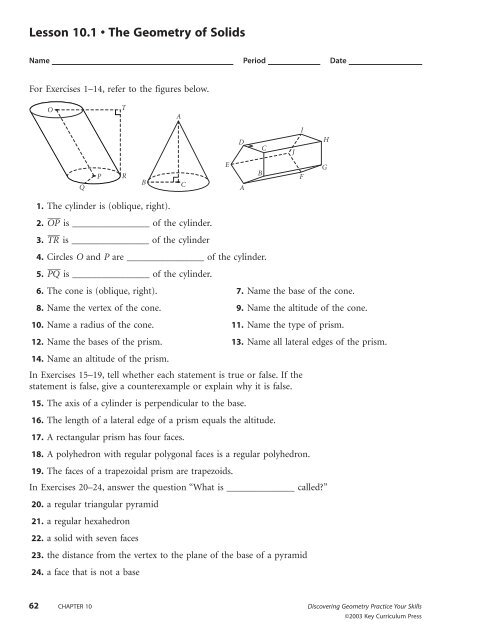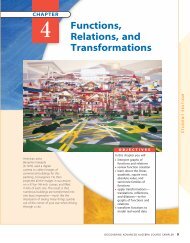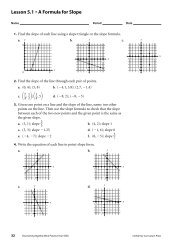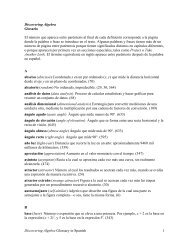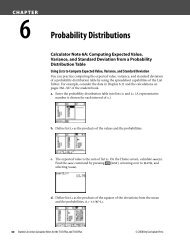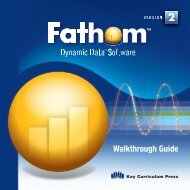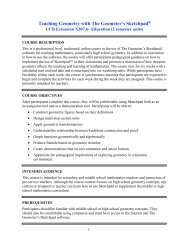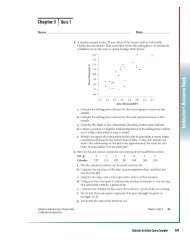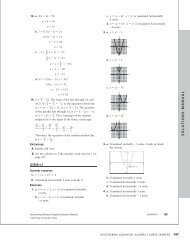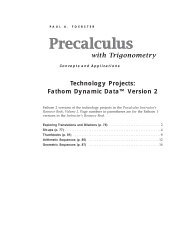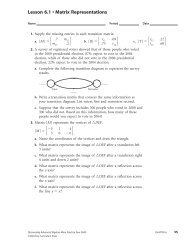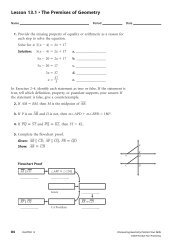Lesson 10.1 • The Geometry of Solids
Lesson 10.1 • The Geometry of Solids
Lesson 10.1 • The Geometry of Solids
You also want an ePaper? Increase the reach of your titles
YUMPU automatically turns print PDFs into web optimized ePapers that Google loves.
<strong>Lesson</strong> <strong>10.1</strong> <strong>•</strong> <strong>The</strong> <strong>Geometry</strong> <strong>of</strong> <strong>Solids</strong><br />
Name Period Date<br />
For Exercises 1–14, refer to the figures below.<br />
O<br />
Q<br />
1. <strong>The</strong> cylinder is (oblique, right).<br />
2. OP is ________________ <strong>of</strong> the cylinder.<br />
3. TR is ________________ <strong>of</strong> the cylinder<br />
4. Circles O and P are ________________ <strong>of</strong> the cylinder.<br />
5. PQ is ________________ <strong>of</strong> the cylinder.<br />
6. <strong>The</strong> cone is (oblique, right). 7. Name the base <strong>of</strong> the cone.<br />
8. Name the vertex <strong>of</strong> the cone. 9. Name the altitude <strong>of</strong> the cone.<br />
10. Name a radius <strong>of</strong> the cone. 11. Name the type <strong>of</strong> prism.<br />
12. Name the bases <strong>of</strong> the prism. 13. Name all lateral edges <strong>of</strong> the prism.<br />
14. Name an altitude <strong>of</strong> the prism.<br />
In Exercises 15–19, tell whether each statement is true or false. If the<br />
statement is false, give a counterexample or explain why it is false.<br />
15. <strong>The</strong> axis <strong>of</strong> a cylinder is perpendicular to the base.<br />
16. <strong>The</strong> length <strong>of</strong> a lateral edge <strong>of</strong> a prism equals the altitude.<br />
17. A rectangular prism has four faces.<br />
18. A polyhedron with regular polygonal faces is a regular polyhedron.<br />
19. <strong>The</strong> faces <strong>of</strong> a trapezoidal prism are trapezoids.<br />
In Exercises 20–24, answer the question “What is ______________ called?”<br />
20. a regular triangular pyramid<br />
21. a regular hexahedron<br />
22. a solid with seven faces<br />
23. the distance from the vertex to the plane <strong>of</strong> the base <strong>of</strong> a pyramid<br />
24. a face that is not a base<br />
P<br />
T<br />
R<br />
A<br />
B C<br />
E<br />
62 CHAPTER 10 Discovering <strong>Geometry</strong> Practice Your Skills<br />
©2003 Key Curriculum Press<br />
D<br />
A<br />
B<br />
C<br />
J<br />
I<br />
F<br />
H<br />
G
<strong>Lesson</strong> 10.2 <strong>•</strong> Volume <strong>of</strong> Prisms and Cylinders<br />
Name Period Date<br />
In Exercises 1–3, find the volume <strong>of</strong> each prism or cylinder.<br />
All measurements are in centimeters. Round your answers to<br />
two decimal places.<br />
1. Right triangular prism 2. Right trapezoidal prism 3. Regular hexagonal prism<br />
In Exercises 4–6, use algebra to express the volume <strong>of</strong> each solid.<br />
4. Right rectangular prism 5. Right cylinder; 6. Right rectangular prism<br />
base circumference p and half <strong>of</strong> a cylinder<br />
x<br />
6<br />
4y<br />
10<br />
2x 3<br />
14<br />
6<br />
7. You need to build a set <strong>of</strong> solid cement steps for the entrance<br />
to your new house. How many cubic feet <strong>of</strong> cement do<br />
you need?<br />
8. <strong>The</strong> foundation walls in the basement <strong>of</strong> your new house will be<br />
8 in. thick and 6 ft high. <strong>The</strong> basement is 24 ft by 32 ft. <strong>The</strong> floor Wall<br />
is 4 in. thick. Under the walls is a 1-ft-wide-by-1-ft-deep footer.<br />
Ignoring windows and doors, about how many cubic yards <strong>of</strong><br />
cement will you need for the walls, floor, and footer? Footer<br />
6<br />
3<br />
8<br />
5<br />
h<br />
4<br />
2x<br />
3x<br />
y<br />
8 in.<br />
10<br />
3 ft<br />
Basement<br />
Floor<br />
Gravel<br />
Discovering <strong>Geometry</strong> Practice Your Skills CHAPTER 10 63<br />
©2003 Key Curriculum Press<br />
6 in.
<strong>Lesson</strong> 10.3 <strong>•</strong> Volume <strong>of</strong> Pyramids and Cones<br />
Name Period Date<br />
In Exercises 1–3, find the volume <strong>of</strong> each solid. All measurements are in<br />
centimeters. Round your answers to two decimal places.<br />
1. Rectangular pyramid; OP 6 2. Right hexagonal pyramid 3. Half <strong>of</strong> a right cone<br />
8<br />
In Exercises 4–6, use algebra to express the volume <strong>of</strong> each solid.<br />
4. 5. 6. <strong>The</strong> solid generated by<br />
30x<br />
b<br />
2a<br />
spinning ABC about<br />
the axis<br />
A<br />
7x<br />
O<br />
In Exercises 7–10, tell which volume is larger. Answer “C” if they are equal.<br />
7. A. B.<br />
8. A. B.<br />
9. A. B.<br />
x<br />
P<br />
25x<br />
4x<br />
10. A. B.<br />
8a<br />
5<br />
8x<br />
3y 5x<br />
2x<br />
3a<br />
5a<br />
6<br />
9<br />
64 CHAPTER 10 Discovering <strong>Geometry</strong> Practice Your Skills<br />
12x<br />
2x<br />
5a<br />
3y<br />
3a<br />
6x<br />
5x<br />
3x<br />
8a<br />
x<br />
14<br />
3x<br />
25<br />
C<br />
2y<br />
B<br />
©2003 Key Curriculum Press
<strong>Lesson</strong> 10.4 <strong>•</strong> Volume Problems<br />
Name Period Date<br />
1. <strong>The</strong> volume <strong>of</strong> a pyramid with an isosceles triangular base is 240 cm 2<br />
and its height is 20 cm. <strong>The</strong> base <strong>of</strong> the base triangle is 6 cm. What is<br />
the length <strong>of</strong> the other two sides <strong>of</strong> the base?<br />
2. A cylindrical oil drum holds 500 gallons. 1 cubic foot 7.5 gallons.<br />
If the diameter <strong>of</strong> the drum is 3.5 feet, about how high is it? Round<br />
your answer to 0.01 feet.<br />
3. Use geometry tools to find the volume <strong>of</strong> one sheet <strong>of</strong> standard<br />
8.5-in.-by-11-in. paper. Describe your method.<br />
4. Jerry is packing cylindrical cans with diameter 6 in. and height 10 in.<br />
tightly into a box that measures 3 ft by 2 ft by 1 ft. All rows must<br />
contain the same number <strong>of</strong> cans. <strong>The</strong> cans can touch each other. He<br />
then fills all the empty space in the box with packing foam. How many<br />
cans can Jerry pack in one box? Find the volume <strong>of</strong> packing foam he<br />
uses. What percentage <strong>of</strong> the box’s volume is filled by the foam?<br />
5. Answer Exercise 4 for a box measuring 5 ft by 2 ft by 1 ft.<br />
6. A square pyramid resting on its base is filled to half its height with<br />
320 cm 3 <strong>of</strong> water. How much water is needed to finish filling<br />
the pyramid?<br />
7. A king-size waterbed mattress measures 72 in. by 84 in. by 9 in. Water<br />
weighs 62.4 pounds per cubic foot. An empty mattress weighs<br />
35 pounds. How much does a full mattress weigh?<br />
8. Square pyramid ABCDE, with the largest possible volume, is cut out<br />
<strong>of</strong> a cube with side length 2 cm. Find the volume and surface area <strong>of</strong><br />
the pyramid.<br />
9. In Dingwall the town engineers have contracted for a new water<br />
storage tank. <strong>The</strong> tank is cylindrical with a base 25 ft in diameter<br />
and a height <strong>of</strong> 30 ft. One cubic foot holds about 7.5 gallons <strong>of</strong><br />
water. About how many gallons will the new storage tank hold?<br />
10. <strong>The</strong> North County Sand and Gravel Company stockpiles sand<br />
to use on the icy roads in the northern rural counties <strong>of</strong> the<br />
state. Sand is brought in by tandem trailers that carry 12 m 3<br />
each. <strong>The</strong> engineers know that when the pile <strong>of</strong> sand, which is in<br />
the shape <strong>of</strong> a cone, is 17 m across and 9 m high they will have<br />
enough for a normal winter. How many truckloads are needed to<br />
build the pile?<br />
A B<br />
Discovering <strong>Geometry</strong> Practice Your Skills CHAPTER 10 65<br />
©2003 Key Curriculum Press<br />
E<br />
D<br />
C
<strong>Lesson</strong> 10.5 <strong>•</strong> Displacement and Density<br />
Name Period Date<br />
1. A stone is placed in a 5-cm-diameter graduated cylinder, causing the<br />
water level in the cylinder to rise 2.7 cm. What is the volume <strong>of</strong><br />
the stone?<br />
2. A 141 g steel marble is submerged in a rectangular prism with base<br />
5 cm by 6 cm. <strong>The</strong> water rises 0.6 cm. What is the density <strong>of</strong> the steel?<br />
3. A solid wood toy boat with a mass <strong>of</strong> 325 g raises the water level <strong>of</strong> a<br />
50-cm-by-40-cm aquarium 0.3 cm. What is the density <strong>of</strong> the wood?<br />
4. For Awards Night at Baddeck High School, the math club is<br />
designing small solid silver pyramids. <strong>The</strong> base <strong>of</strong> the pyramids will<br />
be a 2-in.-by-2-in. square. <strong>The</strong> pyramids should not weigh more than<br />
2 1<br />
<br />
2 pounds. One cubic foot <strong>of</strong> silver weighs 655 pounds. What is the<br />
maximum height <strong>of</strong> the pyramids?<br />
5. While he hikes in the Gold Country <strong>of</strong> northern California, Sid<br />
dreams about the adventurers that walked the same trails years ago.<br />
He suddenly kicks a small bright yellowish nugget. Could it be gold?<br />
Sid quickly makes a balance scale using his walking stick and finds that<br />
the nugget has the same mass as the uneaten half <strong>of</strong> his 330 g nutrition<br />
bar. He then drops the stone into his water bottle, which has a 2.5 cm<br />
radius, and notes that the water level goes up 0.9 cm. Has Sid struck<br />
gold? Explain your reasoning. (Refer to the density chart in<br />
<strong>Lesson</strong> 10.5 in your book.)<br />
66 CHAPTER 10 Discovering <strong>Geometry</strong> Practice Your Skills<br />
©2003 Key Curriculum Press
<strong>Lesson</strong> 10.6 <strong>•</strong> Volume <strong>of</strong> a Sphere<br />
Name Period Date<br />
In Exercises 1–4, find the volume <strong>of</strong> each solid. All measurements are in<br />
centimeters. Round your answers to 0.1 cm 3 .<br />
1. 2. 3.<br />
5<br />
4. Cylinder with<br />
hemisphere taken<br />
out <strong>of</strong> the top<br />
5. A sphere has volume 221 5<br />
6 cm3 . What is its diameter?<br />
6. A sphere has a great circle circumference <strong>of</strong> 40 ft. What is its volume?<br />
7. <strong>The</strong> area <strong>of</strong> the largest section <strong>of</strong> a sphere is 225 in. 2 . What is<br />
its volume?<br />
8. A hemisphere has base area x cm2 and volume x cm3 . What is its radius?<br />
In Exercises 9 and 10, find the volume <strong>of</strong> the solid generated by spinning<br />
each figure about the y-axis.<br />
9. mABC<br />
90° 10. ABC<br />
and DEF<br />
are semicircles.<br />
(0, 5) A<br />
y<br />
6.5<br />
(0, –3) E D (5, –3)<br />
B<br />
C (5, 0)<br />
x<br />
90°<br />
(0, 4) A<br />
(0, 3) F<br />
(0, –3) D<br />
(0, –4) C<br />
11. Eight wooden spheres with radii 3 in. are packed snuggly into a square<br />
box 12 in. on one side. <strong>The</strong> remaining space is filled with packing<br />
beads. What is the volume occupied by the packing beads? What<br />
percentage <strong>of</strong> the volume <strong>of</strong> the box is filled with beads?<br />
12. <strong>The</strong> radius <strong>of</strong> Earth is about 6378 km, and the radius <strong>of</strong> Mercury is<br />
about 2440 km. About how many times greater is the volume <strong>of</strong> Earth<br />
than that <strong>of</strong> Mercury?<br />
1.5<br />
y<br />
5<br />
5<br />
B (4, 0)<br />
x<br />
E (3, 0)<br />
Discovering <strong>Geometry</strong> Practice Your Skills CHAPTER 10 67<br />
©2003 Key Curriculum Press<br />
9<br />
4
<strong>Lesson</strong> 10.7 <strong>•</strong> Surface Area <strong>of</strong> a Sphere<br />
Name Period Date<br />
In Exercises 1–4, find the volume and total surface area <strong>of</strong> each solid.<br />
All measurements are in centimeters. Round your answers to the nearest<br />
0.1 cm.<br />
1. 2. 3. 4.<br />
5. If the surface area <strong>of</strong> a sphere is 196 cm 2 , find its volume.<br />
6. If the surface area <strong>of</strong> a sphere is 48.3 cm 2 , find its diameter.<br />
7. If the volume <strong>of</strong> a sphere is 635 cm 3 , find its surface area.<br />
8. If the surface area <strong>of</strong> a sphere equals the surface area <strong>of</strong> a cube, what is<br />
the ratio <strong>of</strong> the volume <strong>of</strong> the sphere to the volume <strong>of</strong> the cube?<br />
In Exercises 9 and 10, find the surface area <strong>of</strong> the solid generated by<br />
spinning each figure about the y-axis.<br />
9. ABC<br />
and CDE<br />
are semicircles. 10. mABC<br />
90°<br />
(–2, –2) D<br />
(0, 6) A<br />
C<br />
7.2<br />
y<br />
E (0, –4)<br />
B (3, 3)<br />
x<br />
4<br />
(0, 5) A<br />
11. Lobster fishers in Maine <strong>of</strong>ten use spherical buoys to mark their lobster<br />
traps. Every year the buoys must be repainted. An average buoy has a<br />
12 in. diameter, and an average fisher has about 500 buoys. A quart <strong>of</strong><br />
marine paint covers 175 ft 2 . How many quarts <strong>of</strong> paint does an average<br />
fisher need each year?<br />
7<br />
5<br />
y<br />
B<br />
8<br />
E (0, –6)<br />
C (3, 2)<br />
D (6, 2)<br />
x<br />
3<br />
3 3<br />
68 CHAPTER 10 Discovering <strong>Geometry</strong> Practice Your Skills<br />
©2003 Key Curriculum Press


